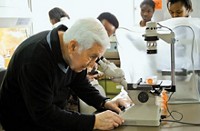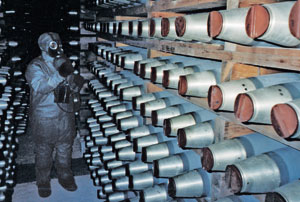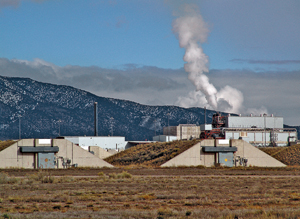Advertisement
Grab your lab coat. Let's get started
Welcome!
Welcome!
Create an account below to get 6 C&EN articles per month, receive newsletters and more - all free.
It seems this is your first time logging in online. Please enter the following information to continue.
As an ACS member you automatically get access to this site. All we need is few more details to create your reading experience.
Not you? Sign in with a different account.
Not you? Sign in with a different account.
ERROR 1
ERROR 1
ERROR 2
ERROR 2
ERROR 2
ERROR 2
ERROR 2
Password and Confirm password must match.
If you have an ACS member number, please enter it here so we can link this account to your membership. (optional)
ERROR 2
ACS values your privacy. By submitting your information, you are gaining access to C&EN and subscribing to our weekly newsletter. We use the information you provide to make your reading experience better, and we will never sell your data to third party members.
Environment
The Shchuch'ye Dilemma
Civil unrest could undermine construction of a Russian chemical arms disposal facility
by Lois R. Ember
November 7, 2005
| A version of this story appeared in
Volume 83, Issue 45

One of the world's largest industrial complexes is being built on the outskirts of Russia's remote, impoverished agricultural region of Shchuch'ye. Instead of being a boon to the local economy and raising the standard of living, construction of this sprawling chemical weapons destruction facility has made life harsher for the desperate local population.
International funding for building the disposal facility largely ignores the socioeconomic issues that could ultimately hobble the project. A recent study by Global Green USA's Legacy Program lays out the civilian issues beyond the fence line that could clash with the laudable effort to rid the world of deadly weapons.
The situation is becoming a potential firestorm of political confrontation between Russian federal and local officials and the affected citizens, warns Paul F. Walker, director of Global Green USA's Legacy Program. Global Green USA is an affiliate of Mikhail Gorbachev's Green Cross International.
In the study, the authors note that they have become increasingly concerned that the area's destitute conditions, in combination with the presence of a dangerous weapons stockpile and an expensive destruction facility, will create a perfect storm' of problems that could ultimately derail the project.
There's a history of similar projects being halted. In the mid to late 1980s, the Soviets secretly constructed a chemical weapons destruction facility at a military base at Chapayevsk, 500 miles southeast of Moscow. The facility, which came to light in 1989, was to receive and destroy all of the Soviet Union's chemical weapons.
Local citizens rebelled when they realized that tens of thousands of tons of deadly weapons were to be shipped to their backyard. In the first visible sign of citizen activism in the final throes of the Soviet era, the citizens set up a permanent, round-the-clock protest encampment in front of the facility.
The Soviet government eventually caved in and, in late 1989, declared that Chapayevsk would be used only for training. Actual destruction facilities, government officials said, would be built near seven existing chemical weapons storage sites, including the one at Shchuch'ye.
At first glance, Shchuch'ye-in the rural area east of the Ural Mountains in the westernmost part of the Siberian Steppes-appears pastoral. But Walker describes the area as the chronically unemployed inhabitants might: It is very flat, very wet, very agriculturally based, and very poor. To Walker, it seems like the end of the world.
Most of the people live in single-story wooden homes with outhouses in the back, no running water, and little heat and electricity. Winter temperatures hover well below freezing, and the thermometer can climb to 95 F during mosquito-infested summer days.
The rutted dirt roads of Shchuch'ye are flooded much of the time, especially in the spring. Heavy trucks used to haul building material and equipment to the destruction facility have further damaged them. With no public transportation, residents are forced to walk these muddy roads to carry out their daily chores.
The largest town in the region-also called Shchuch'ye-has a population of about 11,000 and serves as the administrative hub for the surrounding 15 villages of around 15,000 people. Conditions are so dire and the future so grim that the area's young people are leaving, and the unemployed elderly are left behind to survive on retirement incomes of about $20 a month. Housing, Walker says, is largely free. Gas, electricity, and water, however, cost a total of $50 or more a month, far beyond the means of the retirees. Bills go unpaid, and utilities get turned off.
Even if the retirees could afford to pay for water, it became unavailable because the destruction facility-about 15 miles from the town of Shchuch'ye-required a high-pressure water pipeline. Most of the old, corroded, and poorly maintained water-distribution lines in the town were blown out by the higher water pressure required by the destruction facility.
As a result, water has been shut off to most of the population for the past two years. Townspeople now draw water from wells and carry it home in buckets.
The pipeline was built by the Global Partnership (GP), a coalition of about 24 countries that came together in 2002 to help Russia secure and eliminate its nuclear, chemical, and biological weapons. The partnership, whose nucleus is the Group of Eight industrialized nations-Canada, France, Germany, Italy, Japan, Russia, the U.K., and the U.S.-pledged up to $20 billion over a 10-year period to underwrite the disposal of the former Soviet Union's weapons of mass destruction.
Five miles north of the town lies a facility storing 5,400 tons of the deadly nerve agent VX. The Shchuch'ye stockpile accounts for about 14% of Russia's total declared stocks of 40,000 tons.

Fourteen percent is not an especially impressive figure. But the Shchuch'ye stockpile contains about 2 million portable VX-filled artillery shells that, if stolen, can be diverted to a region south of Russia that is home to known terrorist groups. The stockpile's location near the borders with the now-independent states of the former Soviet Union such as Kazakhstan, plus the weapons' portability and the economic straits of the local population, convinced the U.S. of the need to spend $10 million to secure the site.
Despite the U.S.-funded installation of security fences, guard towers, and electronic surveillance equipment, weapons proliferation remains a constant threat. The specter of proliferation has prompted GP countries to join forces. To date, they have invested more than $1 billion to help Russia get rid of the Shchuch'ye arsenal and meet its obligations under the Chemical Weapons Convention.
The treaty calls for the elimination of all declared chemical weapons by 2012. Russia has destroyed only 2.5% of its declared stocks, according to Rogelio Pfirter, director-general of the Organization for the Prohibition of Chemical Weapons in The Hague.
GP funding is expected to exceed $2 billion by the time the Shchuch'ye facility is opened and turned over to the Russians, perhaps as early as mid-2008. Walker, however, suspects it will more likely be 2009 or 2010.
The destruction complex is about 10 miles north of the stockpile site. Canada is funding the construction of a dedicated railroad that will carry the weapons from the arsenal to the disposal site, which sprawls over 270 acres and is half built. When finally completed, the disposal complex will consist of more than 100 buildings.
Neutralization of the chemical agent VX will take place in the complex's two identical main buildings, one being built by the U.S., the other by Russia. Trains from the stockpile will deliver weapons to these buildings, where automated equipment will first drain VX from the munitions and then hydrolyze the nerve agent.
The waste product of neutralization-called hydrolysate-will be pumped to a third building and mixed with asphalt, and the bituminized hydrolysate will be poured into drums. Once sealed, the drums will be trucked to partially buried storage bunkers in another area of the complex, where they will be stored indefinitely.
Walker says the bituminized hydrolysate is slightly toxic. There will be lots of it produced-more than 50,000 tons that will be stored in the drums, he calculates.
A big question, Walker says, is how the bunkers are to be maintained and whether they will remain weatherproof over the longer term. He says the local citizenry has low confidence in the quality of the bunkers being built by the Russians and in the long-term maintenance and safety of the drums.
The citizens are concerned about potential leakage of toxic wastes into the high water table of the region, Walker explains. And they fear major public health and environmental consequences once the Russians begin operating the facility.
More immediately, citizen angst is being directed at what Walker calls the four-star hotel that the U.S. has built for American workers on the site. It is, Walker says, the most visible and accessible building constructed in the middle of a no-man's land. Remember, he says, The villagers are largely unemployed and in dire poverty, and to them, the hotel is the most visible sign of gross negligence by the Russian federal government and by the GP countries in ignoring the needs of the local community. The hotel's presence has catalyzed complaints and public protests this summer, he notes.
The protests, Walker says, could presage the coming together of factors to produce a perfect storm. On the one hand is the very visible multi-million-dollar investment in the disposal facility. On the other hand, he says, is the growing expectation of the local people for employment opportunities and community investments coupled with almost complete negligence of basic community needs by the Russians and the GP.
To date, Walker says, fewer than 100 out of the total 26,000 population of the Shchuch'ye region have been employed at the disposal facility. Of those employed, many have been schoolteachers, and the legacy program study states that one school was left nearly inoperative as a result.
Igor Khripunov, associate director at the University of Georgia's Center for International Trade & Security, underscores the findings of the legacy program study. Khripunov, formerly a diplomat in the Soviet Union's Ministry of Foreign Affairs, says, The sheer poverty and economic backwardness of the Shchuch'ye area is really appalling.
Khripunov says the destruction facility is instilling in the desperate people of Shchuch'ye and those in the Kurgan Oblast-the state in which Shchuch'ye resides-high, but futile, hopes for better jobs. The facility, he points out, needs highly trained workers, not rural, agricultural workers.
In fact, Khripunov says, an influx of people to Shchuch'ye from the wider Kurgan Oblast may cause a huge problem in maintaining the security of the facility. An influx of poor and ultimately disappointed people could result in more rampant crime, unless the movement of people is controlled, he says.
Such migration can be controlled, Khripunov says, if the area is declared a closed city. And he cites a precedent: The only operational Russian chemical weapons facility is at Gorny, a closed city.

Even without an influx of outsiders, Khripunov can envision the local population becoming more and more restive, perhaps leading to wildcat demonstrations that attempt to stop deliveries to the facility or demand better jobs, more food. He recommends what the legacy program doesn't: the relocation of the Shchuch'ye community.
He sees no future in investing in the local community to improve life for the inhabitants. Rather, he says, it would be preferable to build housing elsewhere in a better environment with better jobs.
It's a radical solution to the problem, Khripunov admits. But it's better than patching up one problem after another as they occur. The GP countries can easily put together several million dollars to help the Shchuch'ye population seek a better life elsewhere, he insists.
As Khripunov points out, international funding for the destruction facility has been restricted to construction within the site's fence line with no consideration for socioeconomic needs beyond the fence. U.S. support, for example, comes from the Defense Department's Cooperative Threat Reduction (CTR) program-the so-called Nunn-Lugar funding mandated by Congress that cannot be used to address the citizens' needs. Those needs, he says, are today the responsibility of the [Russian] Federal Agency for Industry, which is not doing a good job.
Changing the parameters of Nunn-Lugar funding is not politically viable, says a U.S. government official familiar with Shchuch'ye. Beyond-the-fence issues should be a Russian government responsibility, a condition other donor countries concur with, the official says.
The official also does not believe that Shchuch'ye will become another Chapayevsk. It is not very likely given its financial and political profile. The Russian government will not allow it to fail.
Laura S. H. Holgate, vice president for Russia/New Independent States Programs at the nonprofit Nuclear Threat Initiative, says cooperative threat reduction, as a concept, needs to be broader and more comprehensive than Congress has allowed it to be. Holgate, who once managed the CTR program, says, The notion of fences, the notion that one can disaggregate a destruction facility from the community in which it is embedded, is not realistic.
As much as Holgate would like to see changes to the CTR program, she admits that it won't happen without a major rethinking by Congress of how U.S. dollars are spent. Given the politics, she admits, I would be very surprised if it happens.
Advertisement
Still, Holgate adds, it may not even be necessary to broaden the scope of the CTR program because the U.S. is already doing a lot of the outside-the-fence stuff in Russia through U.S. Agency for International Development programs. Once the effectiveness of U.S. AID efforts are proven, she says, more funding could be found and new programs launched.

Craig Williams, director of the Chemical Weapons Working Group that serves as a watchdog of the U.S. destruction program, insists that international financial support for Shchuch'ye must continue. And he complements Holgate's points by adding that there has to be recognition of the importance of community acceptance of the project. Without that acknowledgment, he warns, there is an equal chance that Shchuch'ye will follow the path of Chapayevsk.
Continued confrontation between Russian federal and local government officials and the citizenry could lead, in the best of cases, to a dramatic slowdown in the project's schedule with concomitant increased costs, Walker says. In the worst case, it could lead to long-term stoppage of the project and potential civil disobedience. In either case, the viability of the international treaty is called into question if the 2012 deadline for complete elimination of chemical weapons is missed.
Walker also points out a closer-to-home concern if the Shchuch'ye arsenal is not eliminated: The potential for theft and diversion of these deadly weapons to terrorists has major implications for homeland security.









Join the conversation
Contact the reporter
Submit a Letter to the Editor for publication
Engage with us on Twitter